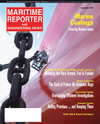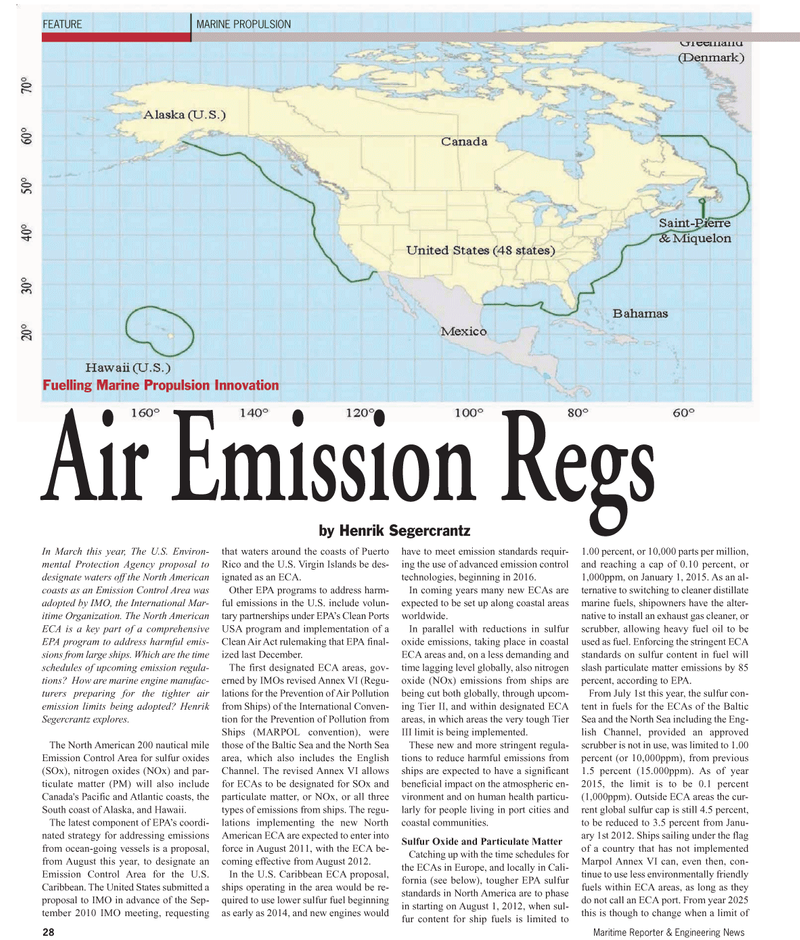
Page 28: of Maritime Reporter Magazine (September 2010)
Marine Propulsion Edition
Read this page in Pdf, Flash or Html5 edition of September 2010 Maritime Reporter Magazine
28 Maritime Reporter & Engineering News
FEATURE MARINE PROPULSION
In March this year, The U.S. Environ- mental Protection Agency proposal to designate waters off the North American coasts as an Emission Control Area was adopted by IMO, the International Mar- itime Organization. The North American
ECA is a key part of a comprehensive
EPA program to address harmful emis- sions from large ships. Which are the time schedules of upcoming emission regula- tions? How are marine engine manufac- turers preparing for the tighter air emission limits being adopted? Henrik
Segercrantz explores.
The North American 200 nautical mile
Emission Control Area for sulfur oxides (SOx), nitrogen oxides (NOx) and par- ticulate matter (PM) will also include
Canada's Pacific and Atlantic coasts, the
South coast of Alaska, and Hawaii.
The latest component of EPA’s coordi- nated strategy for addressing emissions from ocean-going vessels is a proposal, from August this year, to designate an
Emission Control Area for the U.S.
Caribbean. The United States submitted a proposal to IMO in advance of the Sep- tember 2010 IMO meeting, requesting that waters around the coasts of Puerto
Rico and the U.S. Virgin Islands be des- ignated as an ECA.
Other EPA programs to address harm- ful emissions in the U.S. include volun- tary partnerships under EPA’s Clean Ports
USA program and implementation of a
Clean Air Act rulemaking that EPA final- ized last December.
The first designated ECA areas, gov- erned by IMOs revised Annex VI (Regu- lations for the Prevention of Air Pollution from Ships) of the International Conven- tion for the Prevention of Pollution from
Ships (MARPOL convention), were those of the Baltic Sea and the North Sea area, which also includes the English
Channel. The revised Annex VI allows for ECAs to be designated for SOx and particulate matter, or NOx, or all three types of emissions from ships. The regu- lations implementing the new North
American ECA are expected to enter into force in August 2011, with the ECA be- coming effective from August 2012.
In the U.S. Caribbean ECA proposal, ships operating in the area would be re- quired to use lower sulfur fuel beginning as early as 2014, and new engines would have to meet emission standards requir- ing the use of advanced emission control technologies, beginning in 2016.
In coming years many new ECAs are expected to be set up along coastal areas worldwide.
In parallel with reductions in sulfur oxide emissions, taking place in coastal
ECA areas and, on a less demanding and time lagging level globally, also nitrogen oxide (NOx) emissions from ships are being cut both globally, through upcom- ing Tier II, and within designated ECA areas, in which areas the very tough Tier
III limit is being implemented.
These new and more stringent regula- tions to reduce harmful emissions from ships are expected to have a significant beneficial impact on the atmospheric en- vironment and on human health particu- larly for people living in port cities and coastal communities.
Sulfur Oxide and Particulate Matter
Catching up with the time schedules for the ECAs in Europe, and locally in Cali- fornia (see below), tougher EPA sulfur standards in North America are to phase in starting on August 1, 2012, when sul- fur content for ship fuels is limited to 1.00 percent, or 10,000 parts per million, and reaching a cap of 0.10 percent, or 1,000ppm, on January 1, 2015. As an al- ternative to switching to cleaner distillate marine fuels, shipowners have the alter- native to install an exhaust gas cleaner, or scrubber, allowing heavy fuel oil to be used as fuel. Enforcing the stringent ECA standards on sulfur content in fuel will slash particulate matter emissions by 85 percent, according to EPA.
From July 1st this year, the sulfur con- tent in fuels for the ECAs of the Baltic
Sea and the North Sea including the Eng- lish Channel, provided an approved scrubber is not in use, was limited to 1.00 percent (or 10,000ppm), from previous 1.5 percent (15.000ppm). As of year 2015, the limit is to be 0.1 percent (1,000ppm). Outside ECA areas the cur- rent global sulfur cap is still 4.5 percent, to be reduced to 3.5 percent from Janu- ary 1st 2012. Ships sailing under the flag of a country that has not implemented
Marpol Annex VI can, even then, con- tinue to use less environmentally friendly fuels within ECA areas, as long as they do not call an ECA port. From year 2025 this is though to change when a limit of
Air Emission Regs by Henrik Segercrantz
Fuelling Marine Propulsion Innovation

 27
27

 29
29
